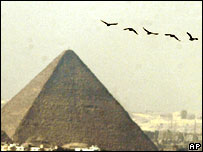H7 discovery in Egyptian ducks raises pandemic threat
 Just when things start getting interesting in Indonesia again, Egypt clamors for attention. This time, a duck along the Nile Delta has tested positive for an H7 avian flu.
Just when things start getting interesting in Indonesia again, Egypt clamors for attention. This time, a duck along the Nile Delta has tested positive for an H7 avian flu.
H7 avian influenza is a milder, low-pathogenic strain. But, as we have seen just a few months ago in Wales, and as we saw in the Netherlands and Germany in 2003, H7 is also ridiculously easy for humans to catch from birds -- and also is apparently quite easy to pass from human to human, or H2H in the shorthand of fludom.
I would add that the two people from Liverpool who caught February's H7N2 in Wales and thought they were going to die, or the relatives of the vet who died in the Netherlands in 2003 from H7N7, would dispute that "mild low path" statement.
The location of this H7-positive duck is in Ash Sharqiyah (Sharkia), located in the North Nile Delta near the Mediterranean Sea. Wait, you say, that sounds familiar. Exactly. Just last month, I talked about the emergence of a new human case of H5N1 infection, that of a 25-year old woman in Damietta. The post is located at http://www.scottmcpherson.net/journal/2007/7/22/new-bird-flu-case-in-egypt.html . Damietta is north of Sharqiyah, but the two governates are uncomfortably close together.
Regrettably, that region of the Nile has also been the location of earlier suspected outbreaks of H5N1 in poultry. And as we have discussed before, the further north you travel up the Nile, the higher the human mortality from H5N1. The Egyptian government is blaming migratory wildfowl -- ducks, to be specific -- for bringing this new strain via Europe. Which is logical, considering the well-documented outbreaks of H7N2, H7N3 and H7N7 that have occurred in Europe since 2003.
Now let's tie all this together. One of the things keeping influenza researchers like Dr. Henry Niman awake at night is the prospect of an H7 flu recombining or reassorting with H5N1 and producing a virus that is much more easily transmissible from human to human, while maintaining the more nasty characteristics of the H5N1 virus. So if H7 is pretty easy to transmit H2H (by all appearances it is), and if H7 and H5N1 could hypothetically evolve, say, in the lungs of a pig or a child or a young adult, then it is reasonable to be concerned. The co-presence of H7 and H5N1 in the same region that has been slammed with avian influenza infections is a grave cause for concern.
Here is the link to Dr. Niman's commentary on just this situation:
http://www.recombinomics.com/News/08210701/H7_Nile_Delta.html

Reader Comments